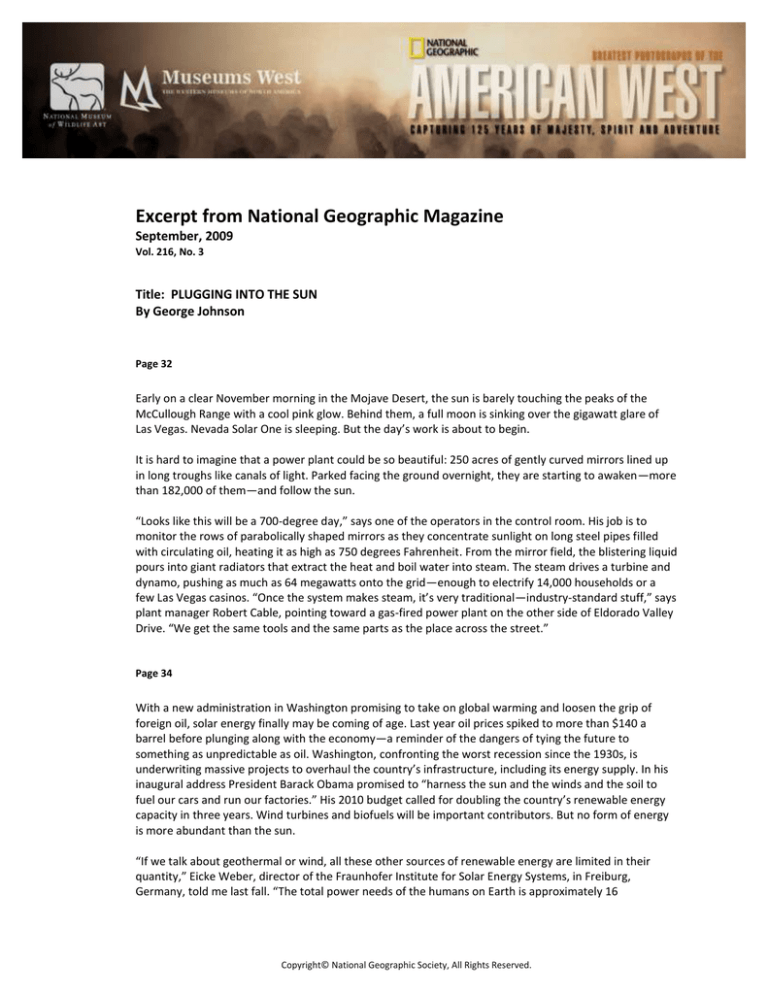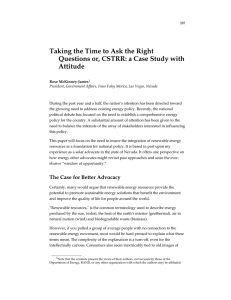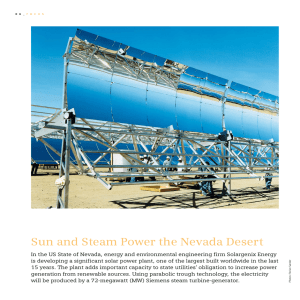
Excerpt from National Geographic Magazine
September, 2009
Vol. 216, No. 3
Title: PLUGGING INTO THE SUN
By George Johnson
Page 32
Early on a clear November morning in the Mojave Desert, the sun is barely touching the peaks of the
McCullough Range with a cool pink glow. Behind them, a full moon is sinking over the gigawatt glare of
Las Vegas. Nevada Solar One is sleeping. But the day’s work is about to begin.
It is hard to imagine that a power plant could be so beautiful: 250 acres of gently curved mirrors lined up
in long troughs like canals of light. Parked facing the ground overnight, they are starting to awaken—more
than 182,000 of them—and follow the sun.
“Looks like this will be a 700-degree day,” says one of the operators in the control room. His job is to
monitor the rows of parabolically shaped mirrors as they concentrate sunlight on long steel pipes filled
with circulating oil, heating it as high as 750 degrees Fahrenheit. From the mirror field, the blistering liquid
pours into giant radiators that extract the heat and boil water into steam. The steam drives a turbine and
dynamo, pushing as much as 64 megawatts onto the grid—enough to electrify 14,000 households or a
few Las Vegas casinos. “Once the system makes steam, it’s very traditional—industry-standard stuff,” says
plant manager Robert Cable, pointing toward a gas-fired power plant on the other side of Eldorado Valley
Drive. “We get the same tools and the same parts as the place across the street.”
Page 34
With a new administration in Washington promising to take on global warming and loosen the grip of
foreign oil, solar energy finally may be coming of age. Last year oil prices spiked to more than $140 a
barrel before plunging along with the economy—a reminder of the dangers of tying the future to
something as unpredictable as oil. Washington, confronting the worst recession since the 1930s, is
underwriting massive projects to overhaul the country’s infrastructure, including its energy supply. In his
inaugural address President Barack Obama promised to “harness the sun and the winds and the soil to
fuel our cars and run our factories.” His 2010 budget called for doubling the country’s renewable energy
capacity in three years. Wind turbines and biofuels will be important contributors. But no form of energy
is more abundant than the sun.
“If we talk about geothermal or wind, all these other sources of renewable energy are limited in their
quantity,” Eicke Weber, director of the Fraunhofer Institute for Solar Energy Systems, in Freiburg,
Germany, told me last fall. “The total power needs of the humans on Earth is approximately 16
Copyright© National Geographic Society, All Rights Reserved.
terawatts,” he said. (A terawatt is a trillion watts.) “In the year 2020 it is expected to grow to 20
terawatts. The sunshine on the solid part of the Earth is 120,000 terawatts. From this perspective, energy
from the sun is virtually unlimited.”
There are two main ways to harness it. The first is to produce steam, either with parabolic troughs like the
ones in Nevada or with a field of flat, computer-guided mirrors, called heliostats, that focus sunlight on a
receiver on top of an enormous “power tower.” The second way is to convert sunlight directly into
electricity with photovoltaic (PV) panels made of semiconductors such as silicon.
Page 35
The optimists say that with steady, incremental improvements—no huge breakthroughs are required—
and with substantial government support, solar power could become as economical and efficient as fossil
fuels. The pessimists say they’ve heard all this before—30 years ago, during the presidency of Jimmy
Carter.
Page 42
No one knows in detail the future of solar energy. But there is a gathering sense that it is wide open—if
we can make the commitment to jump-start the technology. “Originally it seemed like a pie-in-the-sky
idea,” Michelle Price, the energy manager at Nellis, told me last fall when I toured the base’s new
photovoltaic plant. “It didn’t seem possible.” Many things seem possible now.
Page 51
While I was in Nevada, I drove out to Hoover Dam—an early mass producer of renewable electricity—and
joined a tour descending deep inside. At the bottom the torrent of Colorado River water falling from Lake
Mead was spinning two parallel rows of giant turbines. Just one turbine puts out 130 megawatts, twice
the power of Nevada Solar One.
But Hoover Dam left me feeling hopeful. Back on top, as I read the tarnished brass plaques and admired
the art deco architecture, I thought about how this country had met the challenges of the Great
Depression of the 1930s.
The New Deal, as that earlier stimulus package was called, included not only Hoover but also the
Tennessee Valley Authority, which brought hydroelectric power to the Southeast, and the Rural
Electrification Administration, which strung power lines into the heartland. At a time of economic
calamity, the nation’s energy landscape was transformed. Seven decades later we still reap the benefits
every time we flip a switch.
Copyright© National Geographic Society, All Rights Reserved.











